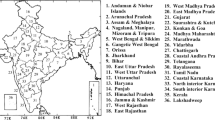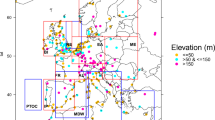Abstract
This work utilized a 37-year (1980–2016) 10 m wind field dataset got from the European Center for Medium Range Weather Forecast (ECMWF) to examine the wind energy potential in the mid-Atlantic by using the Weibull parameters. The region generally showed a fairly good wind characteristics. The computed annual average wind power (170.23 w/m2) attributes the region as fairly suitable for wind power applications. Furthermore, locations such as State of Ceara and Sao Vicente in the southern and northern mid-Atlantic exhibits higher wind power of approximately 330 w/m2 and are therefore suitable for grid connected wind power applications. In all years and seasons, increasing positive trends in wind power density dominate waters between States of Ceara and Amapa in the southern mid-Atlantic. The wind power density showed an increasing trend of 0.13 w/m2/year in the mid-Atlantic throughout the study period. The trend inclined (1.1 w/m2/year) in winter and declined (− 0.51 w/m2/year) during summer.



















Similar content being viewed by others
References
Ahmed AS (2012) Investigation potential wind power generation in South Egypt. J Renew Sustain Energy Rev 16 1528–1536
Ahmed Shata AS, Hanitsch R (2006) The potential of electricity generation on the east coasts on Red Sea in Egypt. Renew Energy 31(10):1597–1615
Akdag SA, Dinler A (2009) A new method to estimate Weibull parameters for wind energy applications. Energy Convers Manage 50(7):1761–1766
Al-Nhoud O, Al-Smairan M (2015) Assessment of wind energy potential as a power generation source in the Azraq South, Northeast Badia, Jordan. Modern Mech Eng 5:87–96. https://doi.org/10.4236/mme.2015.53008
Ammari HD, Maaitah A (2003) Assessment of wind-generation potentiality inJordan using the site effectiveness approach. Energy 28:1579–1592
Bagiorgas HS, Mihalakakou G, Rehman S, AlHadhrami LM (2012) Offshore wind speed and wind power characteristics for ten locations in Aegean and Ionian Seas. J Earth Syst Sci 121(4):975–987
Bailey B, Brennan S, Kinal B, Markus M, Kreiselman J (2002) Long Islands offshore wind energy development potential: phase 1. preliminary, assessment, AWS Scientific
Buflasa HA, Infield Watson S, Thomson M (2008) Wind resource assessment for the Kingdom of Bahrain. Wind Eng 32(5):439–448
Buhairi MHA (2006) A statistical analysis of wind speed data and an assessment of wind energy potential in Taiz-Yemen. Environ Res 9(2):13–21
Dvorak MJ, Archer CL, Jacobson MZ (2009) California offshore wind energy potential. Renew Energy. https://doi.org/10.1016/j.renene.2009.11.022
Elamouri M, Amar FB (2008) Wind energy potential in Tunisia. Renew Energy 33:758–768
Elliott D, Schwartz M (1993) Wind energy potential in the United States. Pacific Northwest Laboratory PNL-SA-23109, Richland, WA
El-Osta W, Califa Y (2003) Prospects of wind power plants in Libya: A case study. Renew Energy 28:363–371
Essa KSM, Mubarak F (2006) Survey and assessment of wind-speed and wind-power inEgypt including air density variation. Wind Eng 30(2):95–106
EWEA (2010) Statistics, Offshore and eastern Europe new growth drivers for wind power in Europe, http://www.ewea.org/index .php?id = 60&no cache = 1&tx ttnews[tt news] = 1896&tx ttnews [backPid] = 1&cHash = 8b64626e4bf6996eea71ec3c08994b0a
Fyrippis I, Axaopoulos PJ, Panayiotou G (2010) Wind energy potential assessment in Naxos Island. Greece Appl Energy 87(2):577–586
Gökçek M, Bayülken A, Bekdemir S (2007) Investigation of wind characteristics and wind energy potential in Kirklareli, Turkey. Renew Energy 32(10):1739–1752
Jamil M, Parsa S, Majidi M (1995) Wind power statistics and evaluation of wind energy density. Renew Energ 6(5–6):623–628
Justus C, Hargraves W, Mikhail A, Graber D (1978) Methods for estimating wind speed frequency distributions. J Appl Meteorol 17(3):350–353
Karamanis D, Tsabaris C, Stamoulis K, Georgopoulos D (2011) Wind energy resources in the Ionian Sea. Renew Energy 36(2):815–822
Khan JK, Ahmed F, Uddin Z, Iqbal ST, Saif UJ, Siddiqui AA, Aijaz A (2015) Determination of Weibull parameter by four numerical methods and prediction of wind speed in Jiwani (Balochistan). J Basic Appl Sci 11:62–68. https://doi.org/10.6000/1927-5129.2015.11.08
Manwell JF, McGowan JG, Rogers AL (2002) Wind energy explained: theory, design and application, Amherst (USA). Wiley, Hoboken
Marafia AH, Ashour HA (2003) Economics of off-shore/on-shore wind energy systems in Qatar. Renew Energy 28:1953–1963
Menendez M, Garcıa-Diez M, Fita L, Fernandez J, Mendez FJ, Gutierrez JM (2014) High-resolution sea wind hindcasts over the Mediterranean area. Clim Dyn 42:1857–1872. https://doi.org/10.1007/s00382-013-1912-8
Ohunakin O, Adaramola M, Oyewola O (2011) Wind energy evaluation for electricity generation using WECS in seven selected locations in Nigeria. Appl Energy 88(9):3197–3206
Onea F, Raileanu A, Rusu E (2015) Evaluation of the wind energy potential in the coastal environment of two enclosed seas. Adv Meteorol 2015:14
Osinowo AA, Lin X, Zhao D, Wang Z (2016) Wind energy potentials and its trend in the South China Sea. Energy Environ Res 6(2):36 (ISSN 1927–0569, E-ISSN 1927–0577)
Osinowo AA, Lin X, Zhao D, Zheng K (2017) On the wind energy resource and its trend in the East China Sea. J Renew Energy 2017:14. https://doi.org/10.1155/2017/9643130 (Hindawi Publishing Corporation)
Rinne H (2010) The Weibull distribution: a handbook. CRC Press, Boca Raton
Rose S, Jaramillo P, Small MJ, Grossmann I, Apt J (2011) Quantifying the hurricane risk to offshore wind turbines. Proc Natl Acad Sci USA 109:3247–3252. https://doi.org/10.1073/pnas.1111769109
Saleh H, Abou El-Azm Aly A, Abdel-Hady S (2012) Assessment of different methods used to estimate Weibull distribution parameters for wind speed in Zafarana wind farm, Suez Gulf, Egypt. Energy 44(1):710–719
Sathyajith M (2006) Wind energy: fundamentals, resource analysis and economics. Springer, Berlin
Stevens M, Smulders P (1979) The estimation of the parameters of the Weibull wind speed distribution for wind energy utilization purposes. Wind Eng 3:132–145
Tchinda R, Kendjio J, Kaptouom E, Njomo D (2000) Estimation of mean wind energy available in far north Cameroon. Energy Convers Manage 41(17):1917–1929
Wilks DS (1995) Statistical methods in the atmospheric sciences: an introduction. Academic Press, San Diego
Xydis G, Koroneos C, Loizidou M (2009) Exergy analysis in a wind speed prognostic model as a wind farm sitting selection tool: a case study in Southern Greece. Appl Energy 86(11):2411–2420
Author information
Authors and Affiliations
Corresponding author
Ethics declarations
Funding
This research did not receive any specific grant from funding agencies in the public, commercial, or not-for-profit sectors.
Rights and permissions
About this article
Cite this article
Osinowo, A.A., Okogbue, E.C., Eresanya, E.O. et al. Evaluation of wind potential and its trends in the mid-Atlantic. Model. Earth Syst. Environ. 3, 1199–1213 (2017). https://doi.org/10.1007/s40808-017-0399-4
Received:
Accepted:
Published:
Issue Date:
DOI: https://doi.org/10.1007/s40808-017-0399-4




